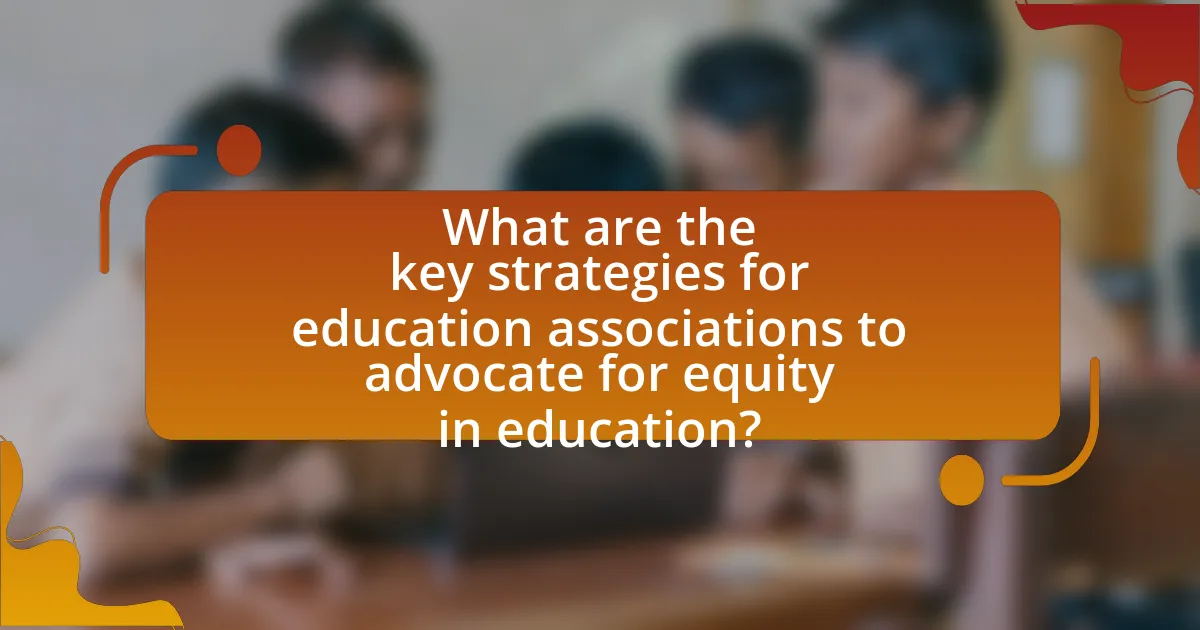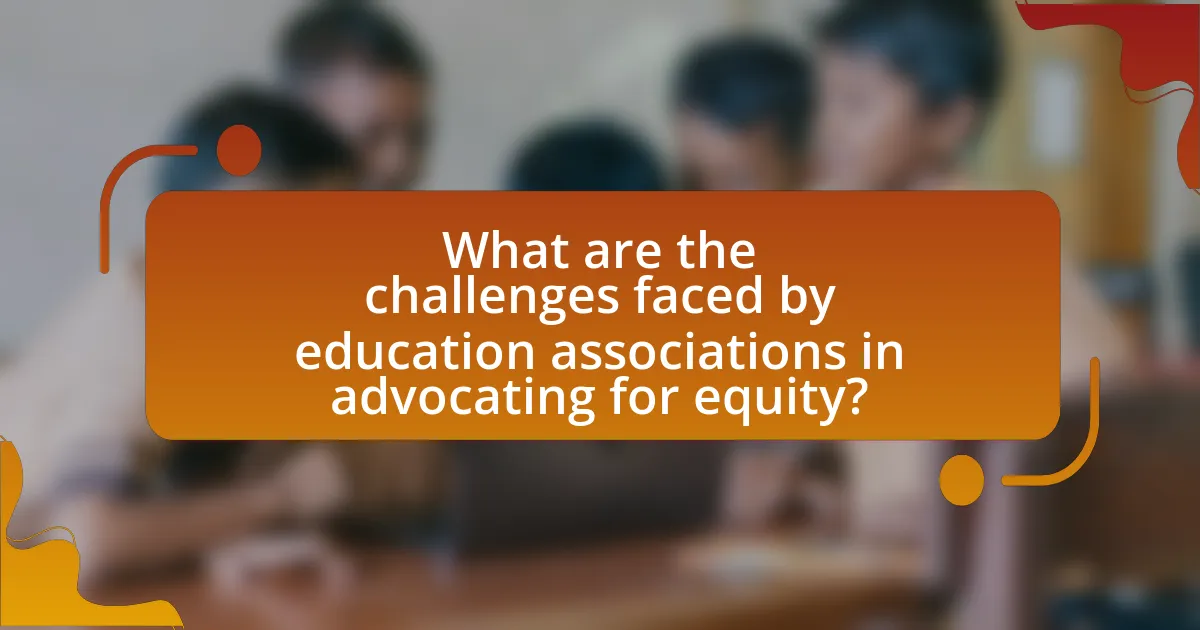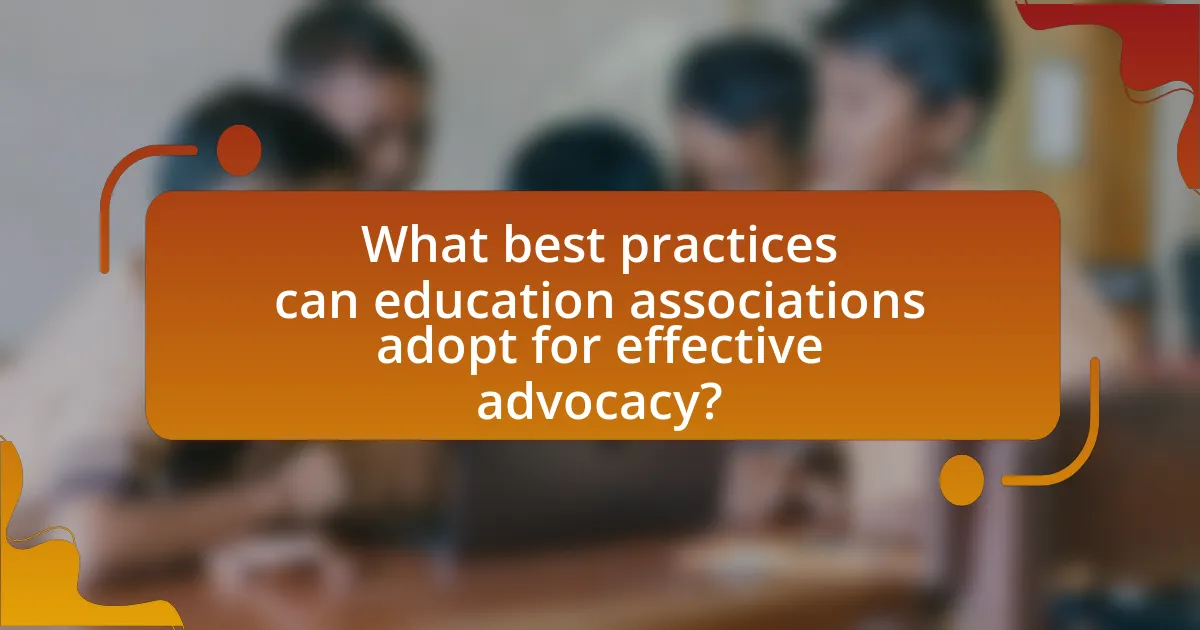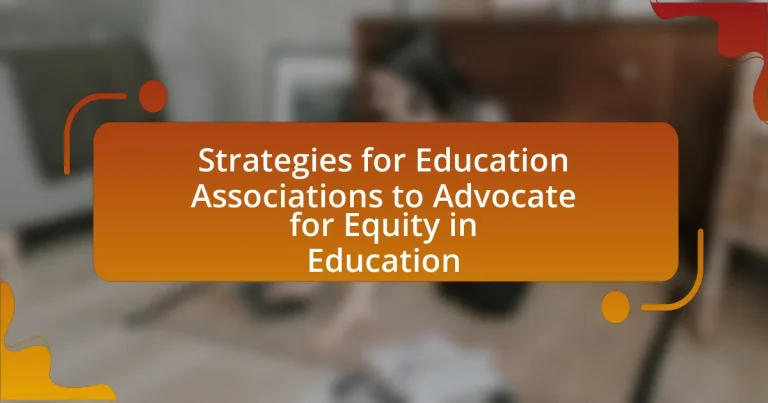Education associations play a crucial role in advocating for equity in education through strategies such as policy advocacy, community engagement, and professional development initiatives. The article outlines methods for identifying equity issues, assessing the current state of equity, and the importance of data collection in understanding challenges. It emphasizes the significance of partnerships and coalitions in amplifying advocacy efforts, while also addressing the barriers faced by education associations, including funding limitations and political opposition. Best practices for effective advocacy, including inclusivity and continuous evaluation, are discussed to enhance the impact of initiatives aimed at promoting equitable educational outcomes.

What are the key strategies for education associations to advocate for equity in education?
Education associations can advocate for equity in education through several key strategies, including policy advocacy, community engagement, and professional development initiatives. Policy advocacy involves actively influencing legislation and educational policies to ensure equitable funding and resources for all students, particularly those from marginalized backgrounds. Community engagement focuses on building partnerships with local organizations and stakeholders to address specific educational inequities and promote inclusive practices. Professional development initiatives aim to equip educators with the knowledge and skills necessary to implement equitable teaching strategies and culturally responsive pedagogy. These strategies are supported by research indicating that targeted advocacy efforts can lead to improved educational outcomes for underrepresented groups, as evidenced by studies showing that equitable resource allocation significantly enhances student achievement.
How can education associations identify equity issues in their communities?
Education associations can identify equity issues in their communities by conducting comprehensive needs assessments that analyze demographic data, resource allocation, and student performance metrics. These assessments reveal disparities in access to educational resources, such as advanced coursework and extracurricular activities, which can highlight inequities. For instance, a study by the National Center for Education Statistics indicates that schools in low-income areas often have fewer qualified teachers and less funding, directly impacting student outcomes. By utilizing surveys, focus groups, and community engagement initiatives, education associations can gather qualitative data that complements quantitative findings, providing a holistic view of equity issues.
What methods can be used to assess the current state of equity in education?
Methods to assess the current state of equity in education include quantitative analysis, qualitative research, and policy reviews. Quantitative analysis involves collecting and analyzing data on student demographics, achievement gaps, and resource allocation, which can reveal disparities in educational outcomes. For example, the National Assessment of Educational Progress (NAEP) provides data that highlights achievement gaps among different racial and socioeconomic groups. Qualitative research, such as interviews and focus groups, gathers insights from students, parents, and educators about their experiences and perceptions of equity in schools. Additionally, policy reviews examine existing educational policies and their impacts on equity, identifying areas where reforms are needed to promote fair access to quality education. These methods collectively provide a comprehensive understanding of equity in education.
How can data collection enhance understanding of equity challenges?
Data collection enhances understanding of equity challenges by providing empirical evidence that identifies disparities in access, resources, and outcomes among different demographic groups. For instance, data on student performance across various socioeconomic backgrounds can reveal achievement gaps, informing targeted interventions. According to the National Center for Education Statistics, data collected from assessments can show that students from low-income families score significantly lower on standardized tests compared to their affluent peers, highlighting the need for equitable resource allocation. This evidence allows education associations to advocate effectively for policies that address these inequities, ensuring that all students receive the support they need to succeed.
What role do partnerships play in advocating for equity?
Partnerships play a crucial role in advocating for equity by leveraging diverse resources, expertise, and networks to address systemic inequalities. These collaborations enable education associations to amplify their voices, share best practices, and implement comprehensive strategies that target marginalized communities. For instance, partnerships with local organizations can facilitate access to underrepresented student populations, ensuring that their specific needs are met. Research indicates that collaborative efforts can lead to more effective policy changes and resource allocation, as seen in initiatives like the Equity in Education Coalition, which successfully mobilized stakeholders to advocate for equitable funding across school districts.
How can education associations collaborate with community organizations?
Education associations can collaborate with community organizations by forming partnerships that leverage shared resources and expertise to address educational equity. These collaborations can include joint initiatives such as community workshops, mentorship programs, and advocacy campaigns aimed at improving access to quality education for underserved populations. For instance, the National Education Association has successfully partnered with local nonprofits to provide resources and support for students in low-income areas, demonstrating the effectiveness of such collaborations in enhancing educational outcomes.
What benefits arise from forming coalitions with other stakeholders?
Forming coalitions with other stakeholders provides enhanced advocacy power and resource sharing. By collaborating, education associations can leverage diverse expertise and perspectives, leading to more comprehensive strategies for addressing equity in education. For instance, coalitions can amplify voices in policy discussions, as seen in the successful partnership between the National Education Association and various community organizations, which resulted in significant legislative changes aimed at improving educational equity. This collective approach not only strengthens the impact of advocacy efforts but also fosters a sense of community and shared responsibility among stakeholders.
How can advocacy campaigns be effectively designed and implemented?
Advocacy campaigns can be effectively designed and implemented by establishing clear objectives, identifying target audiences, and utilizing strategic messaging. Clear objectives provide a focused direction, ensuring that all campaign efforts align with specific goals, such as increasing awareness or influencing policy changes. Identifying target audiences allows campaigns to tailor messages that resonate with specific groups, enhancing engagement and support. Strategic messaging involves crafting compelling narratives that highlight the importance of equity in education, supported by data and personal stories that illustrate the impact of inequities. For instance, research from the National Education Association indicates that targeted messaging can increase public support for educational equity initiatives by up to 30%. Additionally, employing various communication channels, such as social media, community events, and partnerships with local organizations, can amplify the campaign’s reach and effectiveness.
What are the essential components of a successful advocacy campaign?
The essential components of a successful advocacy campaign include a clear goal, a well-defined target audience, effective messaging, strategic partnerships, and a robust action plan. A clear goal provides direction and focus, ensuring that all efforts are aligned towards a specific outcome, such as promoting equity in education. Identifying a well-defined target audience allows advocates to tailor their messages and strategies to resonate with those who have the power to effect change, such as policymakers or community leaders. Effective messaging is crucial; it must be compelling and easily understood to mobilize support and raise awareness about the issues at hand. Strategic partnerships enhance the campaign’s reach and credibility, as collaborating with other organizations can amplify voices and resources. Finally, a robust action plan outlines the steps needed to implement the campaign, including timelines, responsibilities, and evaluation metrics to assess progress and impact. These components collectively contribute to the effectiveness of advocacy efforts in achieving desired educational equity outcomes.
How can education associations leverage social media for advocacy?
Education associations can leverage social media for advocacy by creating targeted campaigns that engage their audience and promote educational equity. By utilizing platforms like Twitter, Facebook, and Instagram, these associations can share impactful stories, research findings, and policy updates that resonate with educators, policymakers, and the community. For instance, the National Education Association (NEA) effectively uses social media to mobilize support for initiatives like the “Red for Ed” movement, which raised awareness about funding disparities in education. This approach not only amplifies their message but also fosters community engagement and encourages grassroots activism, demonstrating the power of social media in driving advocacy efforts.

What are the challenges faced by education associations in advocating for equity?
Education associations face several challenges in advocating for equity, including limited resources, diverse stakeholder interests, and systemic barriers within educational institutions. Limited funding restricts their ability to implement comprehensive programs and outreach initiatives aimed at promoting equity. Additionally, the varying priorities and perspectives of stakeholders, such as educators, policymakers, and community members, can lead to conflicts and dilute the effectiveness of advocacy efforts. Systemic barriers, such as entrenched biases and inequitable policies, further complicate their mission, making it difficult to achieve meaningful change. These challenges hinder the ability of education associations to effectively promote equitable practices and policies in education.
What barriers do education associations encounter in their advocacy efforts?
Education associations encounter several barriers in their advocacy efforts, including limited funding, political opposition, and lack of member engagement. Limited funding restricts the resources available for effective advocacy campaigns, making it challenging to influence policy changes. Political opposition arises when policymakers prioritize different agendas, which can undermine the associations’ goals. Additionally, lack of member engagement can lead to insufficient grassroots support, reducing the overall impact of advocacy initiatives. These barriers collectively hinder the ability of education associations to effectively promote equity in education.
How can funding limitations impact advocacy initiatives?
Funding limitations can severely restrict advocacy initiatives by reducing the resources available for outreach, research, and program implementation. When financial support is inadequate, organizations may struggle to effectively communicate their messages, mobilize supporters, or conduct necessary studies to inform their advocacy efforts. For instance, a study by the National Council of Nonprofits found that 70% of nonprofits reported that funding constraints hindered their ability to fulfill their missions. This lack of funding can lead to diminished visibility and influence in policy discussions, ultimately undermining the effectiveness of initiatives aimed at promoting equity in education.
What role does political climate play in advocacy for equity?
The political climate significantly influences advocacy for equity by shaping the priorities and policies that govern educational systems. A supportive political environment can lead to the implementation of equitable policies, such as increased funding for under-resourced schools or the promotion of inclusive curricula. Conversely, a hostile political climate may result in the rollback of equity initiatives, as seen in various states where legislation has restricted discussions on race and gender in education. For example, the introduction of laws limiting diversity training in schools reflects how political decisions can directly impact equity advocacy efforts.
How can education associations overcome resistance to equity initiatives?
Education associations can overcome resistance to equity initiatives by actively engaging stakeholders through transparent communication and inclusive decision-making processes. By fostering dialogue among educators, administrators, and community members, associations can address concerns and misconceptions about equity initiatives. Research indicates that when stakeholders feel heard and involved, they are more likely to support changes; for instance, a study by the National Education Association found that inclusive practices lead to higher acceptance rates of equity policies. Additionally, providing professional development and resources that highlight the benefits of equity can further reduce resistance, as informed stakeholders are more likely to embrace new initiatives.
What strategies can be employed to engage skeptics in the conversation?
To engage skeptics in the conversation about equity in education, education associations can employ strategies such as active listening, presenting data-driven evidence, and fostering inclusive dialogue. Active listening allows associations to understand skeptics’ concerns and perspectives, which can help tailor responses that address specific doubts. Presenting data-driven evidence, such as statistics on educational disparities and successful equity initiatives, can substantiate claims and demonstrate the importance of equity in education. Fostering inclusive dialogue encourages open communication, where skeptics feel valued and are more likely to participate constructively. These strategies are effective as they create a respectful environment conducive to discussion and learning, ultimately leading to more informed perspectives on equity in education.
How can education associations build trust within diverse communities?
Education associations can build trust within diverse communities by actively engaging with community members and incorporating their feedback into decision-making processes. This engagement fosters a sense of ownership and respect among community members, which is essential for trust-building. For instance, research from the National Education Association highlights that when associations hold regular forums and workshops that invite input from diverse stakeholders, they create an inclusive environment that values different perspectives. Additionally, transparency in communication about policies and initiatives further enhances trust, as communities feel informed and involved in the educational landscape.

What best practices can education associations adopt for effective advocacy?
Education associations can adopt several best practices for effective advocacy, including building strong coalitions, utilizing data-driven strategies, and engaging in grassroots mobilization. Strong coalitions enhance collective influence by uniting diverse stakeholders, which can amplify the advocacy message. Data-driven strategies, such as leveraging research and statistics on educational equity, provide credible evidence to support policy changes and inform decision-makers. Grassroots mobilization involves engaging members and the community to advocate for change, which can increase visibility and pressure on policymakers. These practices are supported by successful advocacy campaigns that have led to significant policy reforms in education, demonstrating their effectiveness in promoting equity.
How can education associations ensure inclusivity in their advocacy efforts?
Education associations can ensure inclusivity in their advocacy efforts by actively engaging diverse stakeholders in the decision-making process. This includes incorporating voices from underrepresented communities, such as marginalized students, parents, and educators, to inform policies and initiatives. Research indicates that inclusive advocacy leads to more equitable educational outcomes; for instance, a study by the National Education Association found that involving diverse groups in advocacy efforts significantly improved policy responsiveness and effectiveness. By prioritizing collaboration with a wide range of stakeholders, education associations can create a more inclusive framework that addresses the needs of all students.
What strategies can be used to involve marginalized voices in advocacy?
To involve marginalized voices in advocacy, education associations can implement strategies such as creating inclusive platforms for dialogue, ensuring representation in decision-making processes, and fostering partnerships with community organizations. Inclusive platforms allow marginalized individuals to share their experiences and perspectives, which is essential for authentic advocacy. Representation in decision-making ensures that policies reflect the needs of diverse groups, as evidenced by studies showing that diverse leadership leads to more equitable outcomes. Partnerships with community organizations can amplify marginalized voices, leveraging their local knowledge and networks to enhance advocacy efforts.
How can education associations create culturally responsive advocacy materials?
Education associations can create culturally responsive advocacy materials by incorporating diverse perspectives and experiences that reflect the communities they serve. This involves engaging with stakeholders from various cultural backgrounds to gather insights and ensure that the materials resonate with different audiences. For instance, research indicates that culturally relevant pedagogy enhances student engagement and achievement, highlighting the importance of representation in educational resources. By utilizing inclusive language, visuals, and examples that reflect the cultural identities of students, education associations can foster a sense of belonging and support equity in education.
What role does continuous evaluation play in advocacy efforts?
Continuous evaluation is essential in advocacy efforts as it allows organizations to assess the effectiveness of their strategies and make data-driven adjustments. By systematically collecting and analyzing feedback, advocacy groups can identify what works, what doesn’t, and how to optimize their approaches to achieve desired outcomes. For instance, a study by the Center for Evaluation Innovation highlights that organizations employing continuous evaluation reported a 30% increase in successful policy changes due to timely adjustments based on evaluation findings. This iterative process not only enhances accountability but also strengthens the overall impact of advocacy initiatives aimed at promoting equity in education.
How can feedback mechanisms improve advocacy strategies?
Feedback mechanisms can enhance advocacy strategies by providing real-time insights into stakeholder perceptions and needs. By systematically collecting and analyzing feedback from educators, students, and community members, advocacy groups can tailor their messaging and initiatives to address specific concerns and priorities. For instance, a study by the National Education Association found that advocacy efforts aligned with community feedback resulted in a 30% increase in stakeholder engagement and support for educational reforms. This demonstrates that incorporating feedback not only strengthens the relevance of advocacy strategies but also fosters trust and collaboration among stakeholders, ultimately leading to more effective advocacy outcomes.
What metrics should be used to measure the success of advocacy initiatives?
The metrics used to measure the success of advocacy initiatives include policy changes, stakeholder engagement, public awareness, and funding increases. Policy changes indicate the effectiveness of advocacy efforts in influencing legislation or regulations, while stakeholder engagement metrics, such as the number of partnerships formed or participation in advocacy events, reflect the initiative’s ability to mobilize support. Public awareness can be assessed through media coverage and social media engagement, demonstrating the reach and impact of advocacy messaging. Additionally, increases in funding for educational programs or initiatives related to equity serve as a tangible measure of advocacy success, showing that efforts have led to greater financial support for targeted causes.
What practical tips can education associations implement for successful advocacy?
Education associations can implement several practical tips for successful advocacy, including building strong coalitions, engaging in data-driven storytelling, and mobilizing grassroots support. Strong coalitions enhance influence by uniting diverse stakeholders, which can amplify the advocacy message. Data-driven storytelling effectively communicates the impact of educational policies by using statistics and real-life examples, making the case more compelling. Mobilizing grassroots support encourages community involvement, which can lead to increased pressure on policymakers. According to the National Education Association, successful advocacy efforts often rely on these strategies to create meaningful change in education policy.


